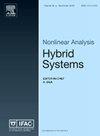Observer-based switched-linear system identification
IF 3.7
2区 计算机科学
Q2 AUTOMATION & CONTROL SYSTEMS
引用次数: 0
Abstract
In this paper, we present a framework to identify discrete-time, single-input/single-output, switched linear systems (SISO-SLSs) from input–output data measurements. Continuous state is not assumed to be measured. The key step is a deadbeat observer-based transformation of the SLS model to a switched auto-regressive with exogenous input (SARX) model. Discrete states are estimated by a three-stage algorithm from input–output data. First, a sparse optimization problem is solved to detect segments with large dwell times. Then, a clustering algorithm is applied to midpoint estimates in these segments, revealing the system order, the number of discrete states, and the observer discrete states. In the third stage, back-transformation from the observer to a finite set of SLS Markov parameters is carried out and a subspace algorithm extracts discrete states from SLS Markov parameters. A MOESP subspace algorithm is also proposed to estimate discrete states directly from input–output data in segments with large dwell times. Switch and discrete-state identifiability issues are carefully examined and persistence of excitation (PE) conditions on input–output data, switching signal, and system structure are derived to retrieve discrete states. Monte Carlo simulations and case studies are presented to illustrate the derived results.
基于观测器的切换线性系统辨识
在本文中,我们提出了一个从输入输出数据测量中识别离散时间,单输入/单输出,切换线性系统(SISO-SLSs)的框架。连续状态不假设被测量。关键步骤是基于无差拍观测器的SLS模型到带有外生输入的切换自回归(SARX)模型的转换。用三阶段算法从输入输出数据估计离散状态。首先,解决了一个稀疏优化问题,以检测驻留时间较大的片段。然后,将聚类算法应用于这些分段的中点估计,揭示系统的顺序、离散状态的数量和观测器的离散状态。第三阶段,将观测器反向变换为有限的SLS马尔可夫参数集,并利用子空间算法从SLS马尔可夫参数中提取离散状态。提出了一种MOESP子空间算法,用于直接从驻留时间较大的段的输入输出数据中估计离散状态。开关和离散状态的可识别性问题仔细检查和激励(PE)条件的持久性输入-输出数据,开关信号,和系统结构推导,以检索离散状态。用蒙特卡罗模拟和实例分析来说明所得结果。
本文章由计算机程序翻译,如有差异,请以英文原文为准。
求助全文
约1分钟内获得全文
求助全文
来源期刊

Nonlinear Analysis-Hybrid Systems
AUTOMATION & CONTROL SYSTEMS-MATHEMATICS, APPLIED
CiteScore
8.30
自引率
9.50%
发文量
65
审稿时长
>12 weeks
期刊介绍:
Nonlinear Analysis: Hybrid Systems welcomes all important research and expository papers in any discipline. Papers that are principally concerned with the theory of hybrid systems should contain significant results indicating relevant applications. Papers that emphasize applications should consist of important real world models and illuminating techniques. Papers that interrelate various aspects of hybrid systems will be most welcome.
 求助内容:
求助内容: 应助结果提醒方式:
应助结果提醒方式:


